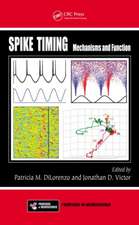Neurotrophic Factors: Methods and Protocols: Methods in Molecular Biology, cartea 1727
Editat de Stephen D. Skaperen Limba Engleză Paperback – 5 sep 2018
Authoritative and practical, Neurotrophic Factors: Methods and Protocols, Second Edition is a valuable resource for a wide audience of readers as they explore nervous system function and pathology.
| Toate formatele și edițiile | Preț | Express |
|---|---|---|
| Paperback (2) | 598.82 lei 38-44 zile | |
| Springer – 5 sep 2018 | 598.82 lei 38-44 zile | |
| Humana Press Inc. – 23 aug 2016 | 896.34 lei 6-8 săpt. | |
| Hardback (2) | 659.70 lei 6-8 săpt. | |
| Humana Press Inc. – 25 feb 2012 | 659.70 lei 6-8 săpt. | |
| Springer – 9 dec 2017 | 966.15 lei 6-8 săpt. |
Din seria Methods in Molecular Biology
- 9%
 Preț: 791.59 lei
Preț: 791.59 lei - 23%
 Preț: 598.56 lei
Preț: 598.56 lei - 20%
 Preț: 882.95 lei
Preț: 882.95 lei -
 Preț: 252.04 lei
Preț: 252.04 lei - 5%
 Preț: 802.69 lei
Preț: 802.69 lei - 5%
 Preț: 729.61 lei
Preț: 729.61 lei - 5%
 Preț: 731.43 lei
Preț: 731.43 lei - 5%
 Preț: 741.30 lei
Preț: 741.30 lei - 5%
 Preț: 747.16 lei
Preț: 747.16 lei - 15%
 Preț: 663.45 lei
Preț: 663.45 lei - 18%
 Preț: 1025.34 lei
Preț: 1025.34 lei - 5%
 Preț: 734.57 lei
Preț: 734.57 lei - 18%
 Preț: 914.20 lei
Preț: 914.20 lei - 15%
 Preț: 664.61 lei
Preț: 664.61 lei - 15%
 Preț: 654.12 lei
Preț: 654.12 lei - 18%
 Preț: 1414.74 lei
Preț: 1414.74 lei - 5%
 Preț: 742.60 lei
Preț: 742.60 lei - 20%
 Preț: 821.63 lei
Preț: 821.63 lei - 18%
 Preț: 972.30 lei
Preț: 972.30 lei - 15%
 Preț: 660.49 lei
Preț: 660.49 lei - 5%
 Preț: 738.41 lei
Preț: 738.41 lei - 18%
 Preț: 984.92 lei
Preț: 984.92 lei - 5%
 Preț: 733.29 lei
Preț: 733.29 lei -
 Preț: 392.58 lei
Preț: 392.58 lei - 5%
 Preț: 746.26 lei
Preț: 746.26 lei - 18%
 Preț: 962.66 lei
Preț: 962.66 lei - 23%
 Preț: 860.21 lei
Preț: 860.21 lei - 15%
 Preț: 652.64 lei
Preț: 652.64 lei - 5%
 Preț: 1055.50 lei
Preț: 1055.50 lei - 23%
 Preț: 883.85 lei
Preț: 883.85 lei - 19%
 Preț: 491.88 lei
Preț: 491.88 lei - 5%
 Preț: 1038.84 lei
Preț: 1038.84 lei - 5%
 Preț: 524.15 lei
Preț: 524.15 lei - 18%
 Preț: 2122.34 lei
Preț: 2122.34 lei - 5%
 Preț: 1299.23 lei
Preț: 1299.23 lei - 5%
 Preț: 1339.10 lei
Preț: 1339.10 lei - 18%
 Preț: 1390.26 lei
Preț: 1390.26 lei - 18%
 Preț: 1395.63 lei
Preț: 1395.63 lei - 18%
 Preț: 1129.65 lei
Preț: 1129.65 lei - 18%
 Preț: 1408.26 lei
Preț: 1408.26 lei - 18%
 Preț: 1124.92 lei
Preț: 1124.92 lei - 18%
 Preț: 966.27 lei
Preț: 966.27 lei - 5%
 Preț: 1299.99 lei
Preț: 1299.99 lei - 5%
 Preț: 1108.51 lei
Preț: 1108.51 lei - 5%
 Preț: 983.72 lei
Preț: 983.72 lei - 5%
 Preț: 728.16 lei
Preț: 728.16 lei - 18%
 Preț: 1118.62 lei
Preț: 1118.62 lei - 18%
 Preț: 955.25 lei
Preț: 955.25 lei - 5%
 Preț: 1035.60 lei
Preț: 1035.60 lei - 18%
 Preț: 1400.35 lei
Preț: 1400.35 lei
Preț: 598.82 lei
Preț vechi: 777.68 lei
-23% Nou
Puncte Express: 898
Preț estimativ în valută:
114.60€ • 118.39$ • 95.38£
114.60€ • 118.39$ • 95.38£
Carte tipărită la comandă
Livrare economică 21-27 martie
Preluare comenzi: 021 569.72.76
Specificații
ISBN-13: 9781493985241
ISBN-10: 1493985248
Pagini: 458
Ilustrații: XV, 458 p. 121 illus., 70 illus. in color.
Dimensiuni: 178 x 254 mm
Ediția:Softcover reprint of the original 2nd ed. 2018
Editura: Springer
Colecția Humana
Seria Methods in Molecular Biology
Locul publicării:New York, NY, United States
ISBN-10: 1493985248
Pagini: 458
Ilustrații: XV, 458 p. 121 illus., 70 illus. in color.
Dimensiuni: 178 x 254 mm
Ediția:Softcover reprint of the original 2nd ed. 2018
Editura: Springer
Colecția Humana
Seria Methods in Molecular Biology
Locul publicării:New York, NY, United States
Cuprins
1. Neurotrophic Factors: An Overview.- Ocular Nerve Growth Factor (NGF) and NGF Eye Drop Application as Paradigms to Investigate NGF Neuroprotective and Reparative Actions.- Culture of Rodent Cortical, Hippocampal, and Striatal Neurons.- Culture of Neonatal Rodent Microglia, Astrocytes, and Oligodendrocytes from Cortex, Spinal Cord, and Cerebellum.- Central Nervous System Neuron-Glia Co-Culture Models and Application to Neuroprotective Agents.- Preparation of Adult Rat Sensory Neuron Cultures and Their Application to Growth Cone Turning Assays.- Sensory Neurons from Tau Transgenic Mice and Their Utility in Drug Screening.- Culture of Rat Mesencephalic Dopaminergic Neurons and Application to Neurotoxic and Neuroprotective Agents.- Culture of Neurons and Smooth Muscle Cells from the Myenteric Plexus of Adult Mice.- Astrocyte/Microglia Co-Cultures as a Model to Study Neuroinflammation.- Micropatterned Geometries Shape Oligodendrocyte and Microglia Plasticity.- Oligodendrocyte Progenitor Cell Cultures: A Model to Screen Neurotrophic Compounds for Myelin Repair.- Cell Enumeration Assays: Application of the MTT and Sulforhodamine B Assays to Lipopolysaccharide-Stimulated Neonatal Rodent Microglia.- Diolistic Labeling and Analysis of Dendritic Spines.- Culture of Mouse Giant Central Nervous System Synapses and Application for Imaging and Electrophysiological Analyses.- Methods for Quantitative Analysis of Axonal Cargo Transport.- Neuronal Cell Morphology in Primary Cerebellar Granule Cells Using High-Content Analysis.- Nerve Growth Factor-Induced Angiogenesis: 1. Endothelial Cell Tube Formation Assay.- Nerve Growth Factor-Induced Angiogenesis: 2. The Quail Chorioallantoic Membrane Assay.- Rat Pancreatic Beta-Cell Culture.- Growth and Neurotrophic Factors in Embryonic Stem Cells.- Site-Specific Direct Labeling of Neurotrophins and Their Receptors: From Biochemistry to Advanced Imaging Applications.- Isolation and Culture of Brain Microvascular Endothelial Cells for In Vitro Blood-Brain Barrier Studies.- Preparation of Rat Hippocampal Organotypic Cultures and Application to Study Amyloid β-Peptide Toxicity.- An Animal Model of Alzheimer Disease Based on the Intrahippocampal Injection of Amyloid β-Peptide (1-42).- Active Induction of Experimental Autoimmune Encephalomyelitis in C57BL/6 Mice.- A Model of Systemic Inflammation to Study Neuroinflammation.- Spared Nerve Injury as a Long-Lasting Model of Neuropathic Pain.- An In Vivo Compression Model of Spinal Cord Injury.- A Controlled Cortical Impact Preclinical Model of Traumatic Brain Injury.- Middle Cerebral Artery Occlusion by an Intraluminal Suture Method.- Primary Motor Neuron Culture to Promote Cellular Viability and Myelination.- Culture of Human Primary Bone Cells and Phenotype Assessment.- Recreating Intestinal Peristalsis in the Petri Dish.- Synthesis of Biocompatible Titanate Nanofibers for Effective Delivery of Neuroprotective Agents.- Preparation and Characterization of Biocompatible Chitosan Nanoparticles for Targeted Brain Delivery of Peptides.
Textul de pe ultima copertă
This volume collects protocols and procedures utilizing cellular, tissue, and whole animal models that can be applied to the investigation of neurotrophic factors and other agents impacting on these systems. It begins with chapters on the culture of neurons and glia from the central and peripheral nervous systems, neuron-glia and glia-glia co-culture models, oligodendrocytes, and cell-based assays for the evaluation of cell vitality. This revised second edition expands to cover methodology encompassing site-specific direct labeling of neurotrophins and their receptors, angiogenesis assays, stem cells, pancreatic beta-cells, axonal transport, synapse biology, dendritic spine analysis, and brain endothelial cells. Subsequent chapters are dedicated to in vivo lesion models of relevance to nervous system pathology, which can be applied to the investigation of neurotrophic factors and peptides, as well as protocols describing nanofiber- and nanoparticle-based methods for brain delivery of neurotrophic agents. Written for the highly successful Methods in Molecular Biology series, chapters include introductions to their respective topics, lists of the necessary materials and reagents, step-by-step, readily reproducible laboratory protocols, and tips on troubleshooting and avoiding known pitfalls.
Authoritative and practical, Neurotrophic Factors: Methods and Protocols, Second Edition is a valuable resource for a wide audience of readers as they explore nervous system function and pathology.
Caracteristici
Includes cutting-edge methods and protocols for the study of neurotrophic factors Provides step-by-step detail essential for reproducible results Contains key notes and implementation advice from the experts
Recenzii
From the reviews:
“It provides a foundation for neurobiological research into the effects of neurotrophic factors and other chemicals on the nervous system. … The audience is broad, including practicing and in training neuroscientists, neurobiologists, and basic neuroscience researchers in human and veterinary medicine, as well as academic neurologists, neurosurgeons, and pharmacists. The methods can be incorporated into basic research laboratories and into medical, biology, and veterinary classes.” (Ramsis Farid Ghaly, Doody’s Book Reviews, July, 2012)
“It provides a foundation for neurobiological research into the effects of neurotrophic factors and other chemicals on the nervous system. … The audience is broad, including practicing and in training neuroscientists, neurobiologists, and basic neuroscience researchers in human and veterinary medicine, as well as academic neurologists, neurosurgeons, and pharmacists. The methods can be incorporated into basic research laboratories and into medical, biology, and veterinary classes.” (Ramsis Farid Ghaly, Doody’s Book Reviews, July, 2012)
















